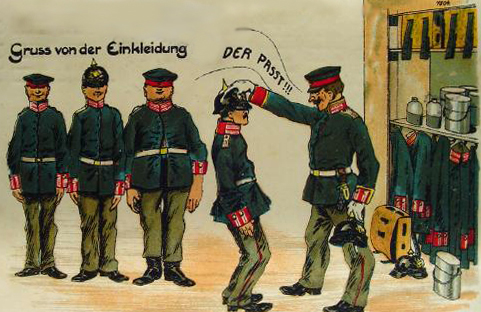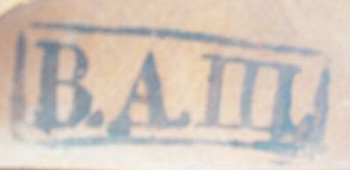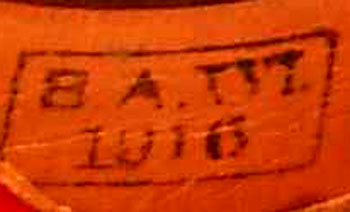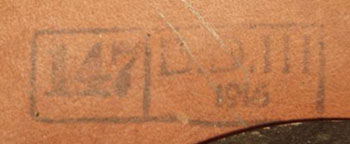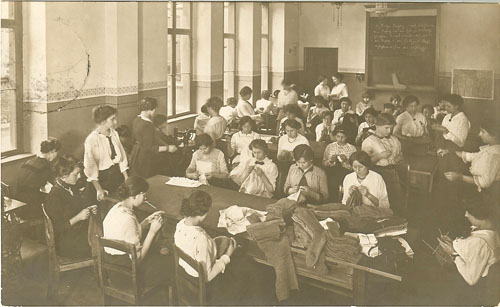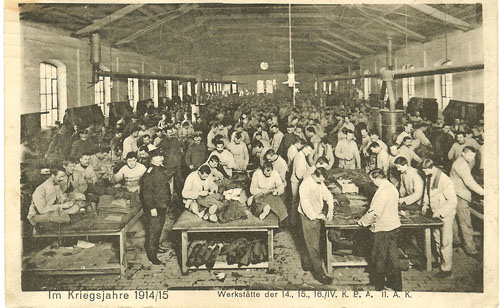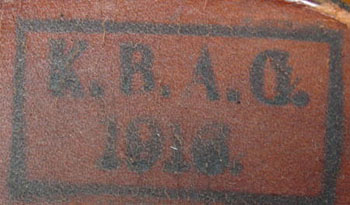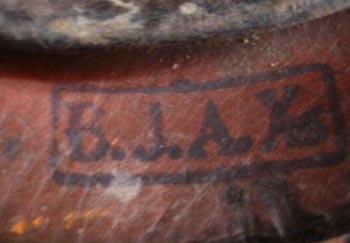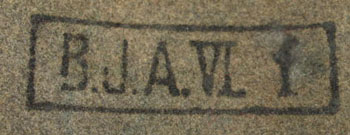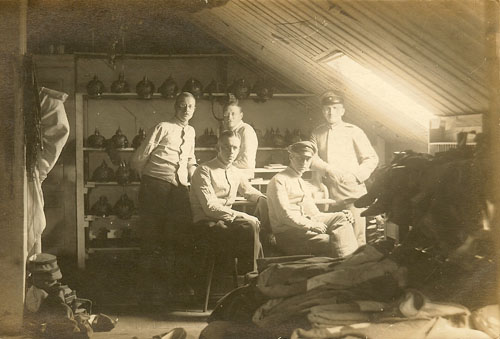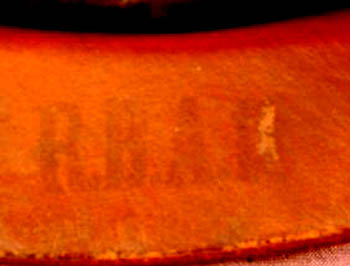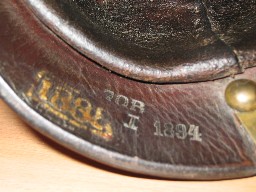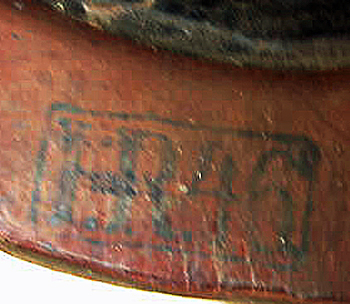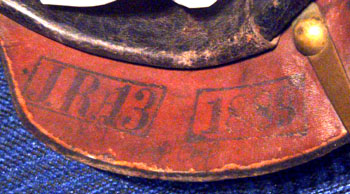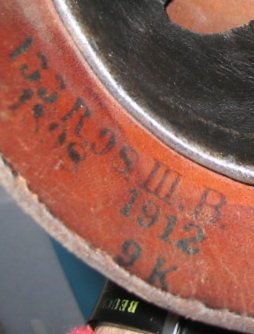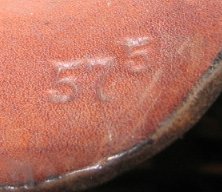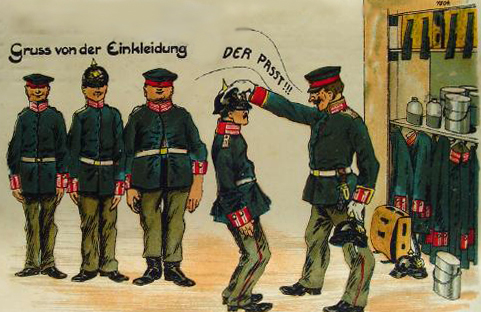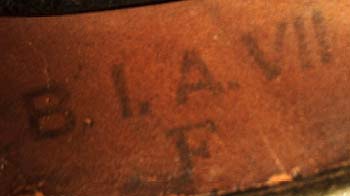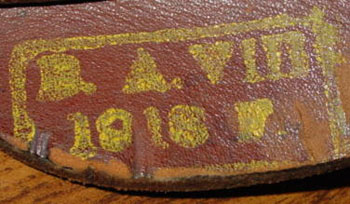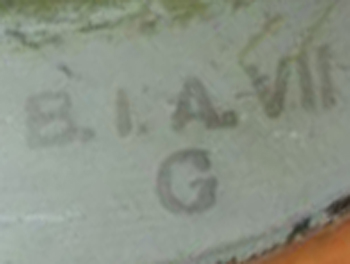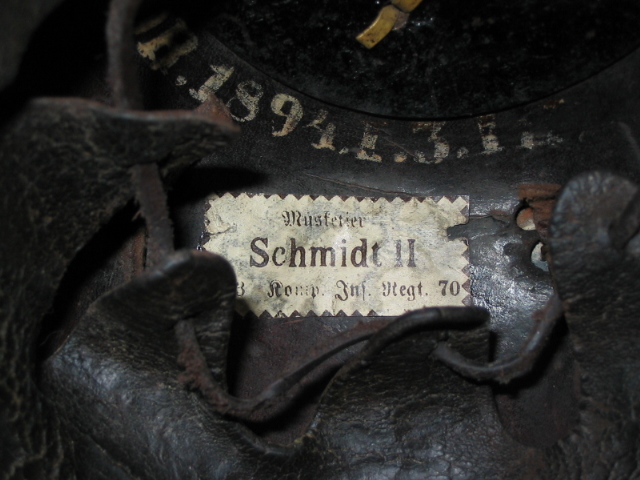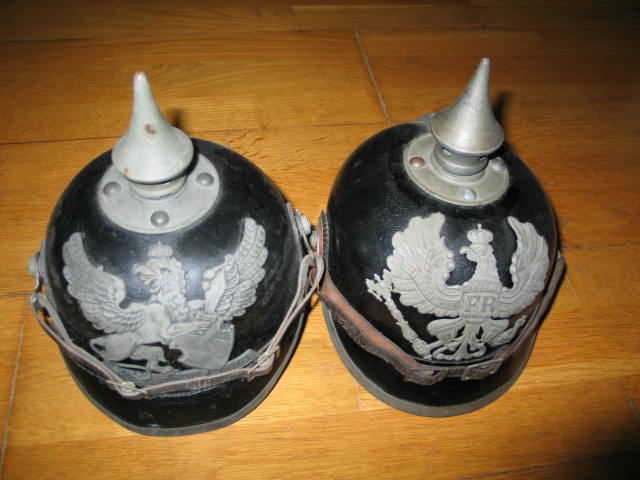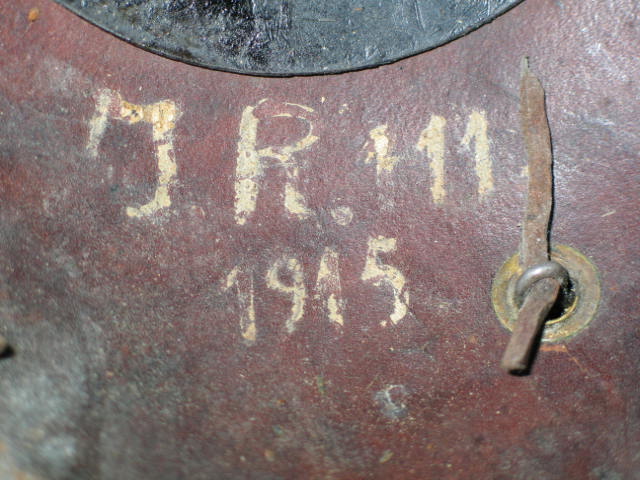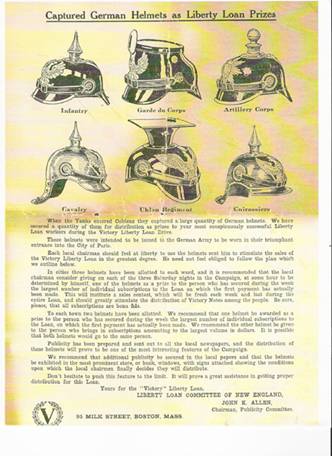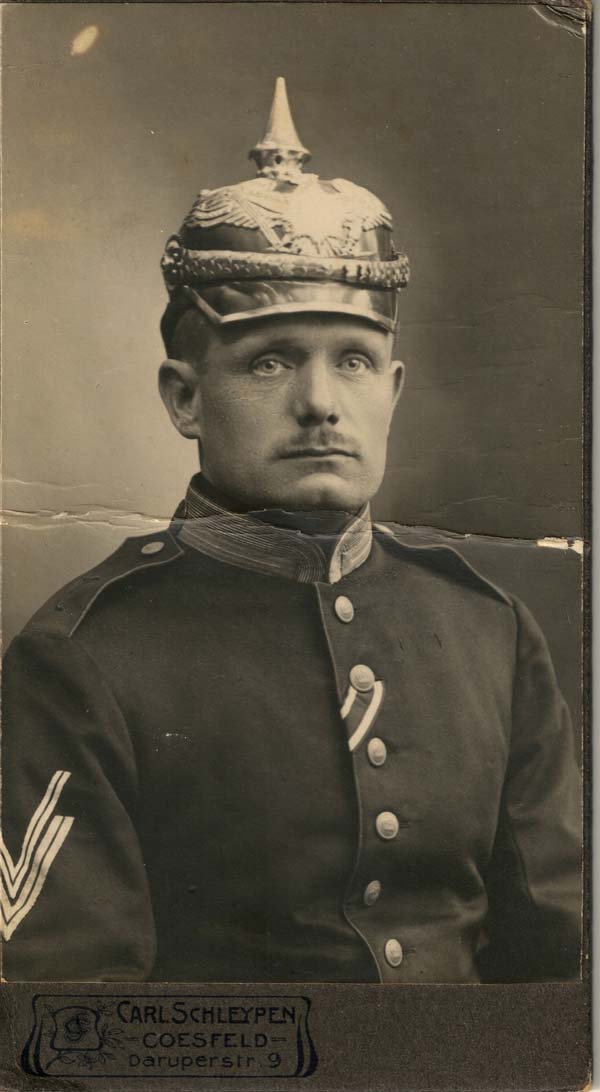Depot Marks
Joseph Robinson and Maxime Chaffotte
22 June 2007 –update Dec. 2014
(This is an international effort. Maxime Chaffotte and I are trying this together. We welcome your improvements!)
We have seen all sorts of stamps and marks on the back visors of issue helmets. By reading the mark much can be learned about the history of the helmet. Private purchase helmets might possibly have a maker’s mark or a size and maybe the owner’s name written in. However, issue helmets seemed designed for stampings from their creation. Understanding these marks is difficult but we can at least explain some of them. Not all helmets were marked the same. Conventional wisdom created the wrong impression when Bowman called these “maker’s marks” in his books. Let us try to clear this issue up a little. These are not maker’s marks. These are identification marks used by the supply system. Makers marks are a different entity and can be seen in a separate article: http://www.pickelhauben.net/helmet-makers
Directives for uniforms, clothing and equipment started with the Prussian War Ministry. Constitutionally, they were empowered to direct the other war ministers. Major changes required an endorsement by the Kaiser (major changes) or the “Kriegsminister” (minor changes). Those changes were published as an “Allerhöchste Kabinettsorder” (A.K.O.) (supreme cabinet order) in the “Armee-Verordnungsblatt” (AVB) issued by the Prussian War Ministry. The AVB are full of those uniform changes in detail. The other three kingdoms took the AKOs found in the AVBs and published them as “Allerhöchste Entschließung” (A.E.), “Allerhöchste Order” (A.O.) or “Allerhöchster Befehl” (A.B.) in their respective local AVB “Verordnungsblättern”. Therefore, adoption of AKOs took place at different times and to different degrees. Saxony, Württemberg, and especially Bavaria maintained some freedom in regards to AKOs. The units attributable to duchies and principalities were part of the Prussian army but in some instances origins were maintained in markings. So you had the primarily Prussian Corps listening directly to the Imperial AKOs and the XIII Corps (Württemberg), XII and XIX Corps (Saxony) and the Bavarians doing variously different things. Also any marking rules were taken as suggestions not mandates. All uniform pieces were specified in detail in the “Bekleidungsordnungen” (Bkl.O.) for NCOs and ORs or in the Offizier Bekleidungs-Vorschriften (O.Bkl.V.) for officers.The officer regulation is translated into English in Appendix A. of Randy Trawnik’s book.
Then the Prussian war ministry issued samples of the uniform or equipment to the army corps. Each corps had a small but very important supply unit called the Bekleidungsamt (BKA or BA). The samples were called Probe and the army corps BKA received them and called for bids from the suppliers of their army corps district. The bids were designed to produce the respective piece of uniform or equipment according to the specifications given by the samples. The Bekleidungsämt had to accept the bids of at least two suppliers per article to avoid monopolies and the image of corruption.
The system of Probe’s or examples changed a lot by kingdom and morphed over time. Do not get the impression that all contractors had to make perfect copies of the Probe. They had to approximate it and of course there were manufacturing differences. This really came into effect once replacement or ersatz helmets came into play. Collectors who see a Probe item, and expect all other helmets of that type to match make many mistakes. Look at the various manufacturers of Kürassier helmets. Those made by Lachmann tend to be identifiable from a distance from the other manufacturers due to the vertical nature of the neck guard. Yet both kinds of helmets were patterned off the same Probe.
It seems however, that 4 of the 25 Corps did not at first glance have an independent BKA. The last army corps to be added XVIII, XX, XXI and III Bavarian Corps seemed to have doubled on an older BKA. We still had 21 BKA. This gives rise to our first mark which was BA. BAXIV for example is the mark for the BKA of the XIV Corps. This example shows BA III.
As each army corps developed their own stamping method is relatively easy to construct similarities by corps. The Prussian BKA frequently had the BKA initials, the corps number and perhaps the date inside of a rectangular box. the box was not always present and the numbers though normally written in the Roman method they are also found with Arabic numbers. These are normally but not always found on the rear visor of a helmet. The Bavarian marks seem to be found in the dome of the helmet for Bavarian Corps I and Bavarian Corps II. Bavarian Corps III seems to have varied significantly when they finally created a BKA in 1916. Rather than a Bekleidungsamt the clothing department in that corps was known as the Bekleidungs Depot (BD) and had a significantly different mark.
The BKA was not standard in size or organization but varied by corps and nationality. In some cases civilians populated the “handwerk” section. Prussian Corps had about 75 NCO and OR types while Bavarians had 200. Wurttemberg’s Corps and the two Saxon Corps had 28 NCOs but no ORs each.VIII Corps in Coblenz seems to have picked up much of the slack in the missing BKAs. They did parts of XVIII Corps, parts of XXI Corps and assorted other units like the NCO school. II Corps picked up XX corps. XV picked up most of XXI Corps. XI Corps picked up Regiment 87 & 88 from XVIII Corps as well as both Eisenbahn Regiment 2 & 3. Mostly I Bavarian Corps but some of II Bavarian Corps picked up Bavarian III Corps. BKAs seem to have come into their own in waves as Corps HQ’s were created. Most corps through corps XV in 1888. Corps XII, XVI-XIX in 1892, Bav. III in 1889. What that signified was a significant shift of how things were marked. As the territory in total did not expand, but the number of Army Corps districts did. Some units that were in Corps number A were moved to Corps number B along with their helmets. The BKA did not mark the helmet at all until something like 1902 and before that the first mark was made to detail regiment and issue date. BKA marks are mostly found in ink. The earliest known use of ink alone is 1873. These were relatively uncommon, and ink did not become the mainstay until almost the 1890s.
Each Clothing Office had a head Beamte in field officers rank and several further officers – all active follwing the reorganisation of the late 1890’s. They were further staffed by a number of officials depending on size, typically in a large office – a Bekleidungsamt-Rendant, 5 Bekleidungsamt-Inpektoren, 1 Bekleidungsamt-Unterinspektor and 15 officials with equivalent NCO rank. Much of the work force hired by the Bekleidungsamt were female. From Dr. L. Meyer`s “Grundzüge der Deutschen Militärverwaltung“, published in 1908. In remarks concerning mobilization of Bekleidungsämter (translation by Glenn Jewison):„The re-enforced Handwerkerabteilung is organized into four parts: Betriebsabteilung I (shoemakers), Betriebsabteilung II to IV (Tailors), which are each further organized into four companies.”
With the outbreak of hostilities the Bekleidungsamt organization exploded in size. They grew to regimental size, commanded by a Colonel, consisting of companies and battalions (Betriebsabteilung). A Bekleidungsamt consisted of 85 officers, 50 Beamte and 3300 workers. The Guard Corps erected a wartime garment department (Kriegs-Bekleidungsamt Gardekorps – K.B.A.G.).
Each Clothing Office had a smaller repair organization (Bekleidungs Instandsetzung BIA or BJA) after mobilization. The Bekleidungs Instandsetzung had only seven officers six Beamte and 300 workers. It was commanded by Captain.
III Bavarian Army Corps created a Bekleidungs Depot (BD) and in Prussia where the XVIII, XX, and XXI corps had no Bekleidungsamt they developed what was called a Reserve Bekleidungsamt (RBA). The reserve Bekleidungsamt seems to have been identical to the other Bekleidungsamt organizations but used different marks as in the example below, for XVIII Corps. I cannot readily explain the difference in name except to note that there had been no Bekleidungsamt in these military districts previously.
The Bekleidungsamt fell under the jurisdiction of the deputy commanding general in the Military District. As each Military District Deputy Commanding General was basically an independent satrap — markings differed by corps Military District. Differences abounded. Location of the stamp, method used, size, and abbreviations differed. Most pre 1895 type helmets had the marking pressed or stamped into the leather. For some there were also painted on marks often in white paint. So you could have different locations, sizes and methods. Do not expect a uniform method of marking. This example shows a mixture of white paint and pressed in marks.
The Bekleidungsamt marking allegedly signified the acceptance of the helmet from the manufacturer but it seems as though it was applied, just prior to being issued to a lower command rather than on acceptance. It could also have a manufacturers stamp or sticker. You would also have a date (in theory) of when the helmet was inspected. As helmets had a wear out date this could ground the inspector in how long this item had been around. The Saxons of XII and XIX Corps also sold helmets marking them as bought.
The BKA then issued the helmet to the Regiment. The regiment then either marked the helmet or did not. There are several different types of regimental markings. The easiest to understand marking is one that says IR # for Infantry Regiment. It is also common to see JR# using the common J to replace I in an effort to avoid confusing it with l.
There is also a common method of #R which is also known as the “Saxon method.”. There are also regimental markings tied to geographic regions and honorary titles.
Regiment passed equipment down to the company level. Battalion and company could be marked into the helmet. These marks varied immensely. Some were not marked by company. Some didn’t even have battalion.Few helmets had markings from all levels but here is an example of 133rd Regiment, 3rd Battalion, 9th Company from 1898
The helmet could be marked at this time with a roman numeral called a garniture mark. This indicated the “goodness” of the helmet. A good model would be marked with one Roman numeral and then further garniture marks would be added as inspections took place and the condition deteriorated. Grades were from I-V with I being the best. For most uniform parts the company had to keep three sets of each article on stock. The best set (erste Garnitur) was only issued for mobilization or parade and was recollected again after parade. Second set (zweite Garnitur) was the “better” service uniform and third set (dritte Garnitur) was the drill and exercise set. For spiked helmets there were only two sets. When soldiers were sent home after service the regiments had to discharge them with a complete uniform (no helmet but cap – Krätzchen) – which was certainly not erste Garnitur.
A leather helmet was supposed to be good for 10 year. When the soldier’s enlistment was up in 2 years the helmet went back to the Kammer. I do not have the stock levels for Kammers but it makes sense that excess helmets were sent back up to the BKA. The subordinate leaders would of course keep the good ones and send those in worse shape back. When it arrived back at the BKA it could be re-inspected and a new garniture grade issued if it had degraded in the previous owner’s use. It was then ready to re-issue. A new date and possibly a new garniture mark added. This example on the left was issued three different times. The company was required to keep two helmets, one that was issued to the soldier. Not all helmets had these marks. According to the estimated life span of the equipment the regiments received an annual budget to purchase equipment from the army corps. If the regiment managed to save money from this budget they could spend it on extra equipment, so called “außeretatmäßige Stücke”. That explains how all those many, many anomalies of regiments found their way into the “official” equipment of a unit. E.g. some cuirassier regiments kept breast armor unofficially after 1888 which had to be paid out of those unofficial savings. The NCOs responsible for the Kammer (Bekleidungs-unteroffizier) were responsible for keeping the company stock (Bekleidungskammer) proper, clean – and profitable! The one on the right is garniture III.
Not only were helmets issued back into the system by the repair facilities with a BIA mark there are other marks used on release that cause confusion. The most common of these is the letter F. The letter is found on many BIA marks as well as BKA marks. it is found both in the capital letter F and the smaller letter f. This was an inspection mark that followed a shorthand wartime garniture system. Because many of the wartime helmets were released from the BIA with repairs this marking is often confused with “repaired”. However, they were also inspected and released from the BKA. The letter in small or capital spelling means “felddienstbrauchbar” or field/war serviceable. The lower-level garniture inspection resulted in code “G” meaning “garnisonsdienstbrauchbar” or garrison / home serviceable only. This marking was often used for obsolete helmet types. This mark was far from universally used. As you as you will reallyThis was a wartime expedient. This replaced the garniture system with just two grades – either F or G.
The tag shown below is not a maker’s mark. These stickers could be purchased at the military effects store. This is a private tag to mark your “stuff”. They often have great information on them. You can see the name, rank, regiment, and company on the second example. This guy is named Schmidt II which means he is the second Schmidt in the company.
Regularly the same suppliers supplied the same corps. While at first this might mean nothing, most makers had similar grommet measurements for their helmets. So all wappen supplied by that maker should have the same measurements between mounting hardware. In a case like the maker Julius Jansen he supplied many of the helmets for both XIV and XV corps. So you can have a Prussian eagle and Baden Griffin on an issue helmet made by Jansen that have the same distance between mounting hardware. The pictures below are of two M15s from Jansen and the two wappen though different have grommets the same distance apart.
Just when you thought you had a handle on it you find other examples that are outside the norm. This one has white paint in the crown of the helmet dated 1916. For some reason Baden Regiment 111 seems to have always used paint (white or black) in the top of the helmet.
Why would my helmet have no marks? There are several reasons and one could buy a Diensthelme that looked an awful lot like an issue helmet but as a private purchase item there would be no marks. Helmets not issued out to units would also bear no marks. As the war went on I think standards in BKA’s slipped to keep pace with the volume so war time helmets are less likely to have marks. As Pickelhaube were phased out in favor of steel helmets inflowing inventory would be stockpiled. Manufacturers were completing contracts and units were being issued steel helmets. Helmets that were stockpiled and not issued would not have a marking. In the same vein many of these stockpiled helmets were supposedly the supply for the thousands of war bond helmets found in the USA. So thousands of good unmarked helmets found their way into family hands.
Friday Feb 7, 1919 THE STARS AND STRIPES newspaper, Page 1, Column 1:
“85,750 Shiny Ones on Way to American
Prussian Guards’ Helmets will help sale of Liberty Bonds
The doughboy guards at Coblenz who kept the keys to the German warehouses where 85,750 Shiny Prussian Guards helmets were stacked are restored to good nature. They eat normally, and no longer dream of great helmet robbery mysteries. For the helmets are out of their custody at last and on their way back to the States. The warehouse keys arent’t needed any longer. The helmets are to be handed out back home to buyers of bonds of the Fight Liberty Loan.
Meanwhile, traders on the AEF souvenir bourse are eagerly watching the tape for the first transatlantic quotation on Helmets.
Word of the 85,750 helmets in one buiding leaped back through the AEF almost before the advance guard of the Third Army settled in Coblenz. Mails from the rear areas of the AEF to the Army of Occupation grew unaccountably large. Every man in the A of O had from six to 60 friends whose latest letters always said after speaking pointedly of lugers and mausers and iron crosses: “And of course I am relying on you to get one of those 85,000 helmets for me.”
The pressure of visitors to the warehouse grew so strong that the chief salvage officer at Third Army Headquarters posted a big sign: No More Helmets Given Out.” (The citation was found by Keith Gill.)
Some of the abbreviations used
A.A. Aufklärungsabteilung
Abt. Abteilung
A.K. Armee Korps
A.M.K Artillerie-Munitions Kolonne
A.N.R. Armee Nachrichten Regiment(signal)
A.R. Artillerie Regiment. Mostly foot artillery but found on one Field Artillery.
B. Battalion
B.A. Bekleidungs Amt- (Followed by a roman or Arabic numeral Corps number)
B.A.G. Bekleidungs Amt Garde
B.A.O Bekleidungs Amt Ostasien
Bat. Batterie
Bay. Bayrisch
B. Battalion or Batterie
B.D. Bekleidungs Depot (Bav. III)
B.I.A. Bekleidungs Instandsetzung (Followed by a roman or Arabic numeral Corps number)
B.I.L.R. Bavarian Infant. Lieb Regiment
B.J.A. Bekleidungs Instandsetzung (Followed by a roman or Arabic numeral Corps number)
BKA Bekleidungs Amt- (Followed by a roman or Arabic numeral Corps number)
Br. Brigade
Brok. Tr. Brücken Train
C. company — old spelling
C.G.R.9 Colbergsches Grenadier Regiment 9
Chev. Leg Chevaulegers
Dic. Division
D.R. Dragooner Regiment
DRGM Deutsches Reichs-Gebrauschs-Muster = registered trade mark in germany
DRP Deutsches Reichspatent
E.B. Ersatz Battalion
E.L.I.R. Ersatz Landwehr Infantry Regiment.
E.R. Eisenbahn Regiment
E.R.I.R. Ersatz Reserve Infantry Regiment
Eisb. R Eisenbahn Regiment
Esk. Eskadron
F or f felddienstbrauchbar–Field wearable (or serviceable)
F.A.R. Feld-Artillerie- Regiment
FB Fusilier Battalion
Fd A.R. Feld-Artillerie- Regiment
Fd. Las Feld Lazarett
F.F.K. Fortress Ferensprecher Kompanie
Flg. B. Flieger Battalion
Fpk. K. Fubrparl Kolonne
F. R. Fusilier Regiment
Fr. Wag. Futter Wagen
F.S. Feld Schmeide
Fs AR Foot Artillery
Fuss A.R. (B) Fuss Artillerie Regiment (Batallion)
G or g garnisonsdienstbrauchbar garrison / home serviceable
Geb. Jäg. R. Gebirgs Jäger Regiment
Geschw. Geschwander (wing)
G.F.R. Garde Fusilier Regiment
G.G.R. Garde Grenadier Regiment
G.G.R.5. 5th Garde Grenadier
3.G.G.K.E. Königen Elisabeth Garde Grenadier
4. G.G. R. K. 4th Garde Grenadier
4.G.G.R.K.A. Königen Augusta. Garde Grenadier
G.J.B. Garde Jäger Battalion
G.K.R. Garde Kürassier Regiment.
G.P.B. Garde Pioneer Battalion
G.R. Grenadier Regiment or Garde Regiment
Gd. Garde
G.R.z.F. Garde Regiment zu Fuß
G.S.B. Garde Schützen Battalion
G.T. Garde Train
H.R. Husaren Regiment
I.L.R. Infantry Lieb Regiment
I.M.K. Infantry Munitions Kolonne
IR Infantry Regiment
5/I.R.88 5th company Infantry Regiment 88.
II/I.R.88 2nd Battalion Infantry Regiment 88
J.B. Jäger Battalion
J.R. Infantry Regiment
K. Kompagnie
K.A.G.G.R.1 Kaiser Alexander 1st Regiment Garde Grenadiers
K.B.A. Kreigs Beckleidungs Amt
K.B.A.G Kreigs Beckleidungs Amt Garde
K.F.R. Kaiser Franz Regiment
K.F.G.G.R.2 Kaiser Franz 2nd Garde Grenadier
Krad. Schtz. Btl. Kraftrad Schutzen Batallion.
Krnk. W. Kranken Wagen
Kür. R Kürassier Regiment
L.B.A. Landwehr Bekleidungs Amt
Lds. Landsturm
Ldw. Landwehr
LG Landgendarme (territorial police) [also Landes Gendarmerie]
L.G.R.8 Lieb Grenadier Regiment 8
L.I.R. Landwehr Infantry Regiment.
M.G.A. Maschinengewehr Abteilung
M.G.K. Maschinengewehrkompanie
MPB 4 Magdeburgisches Pionier-Battalion Nr. 4.
OJR 78 Ostfriesische Infantry regiment 78
OJR 91 Oldenburg Infantry Regiment 91
P.B. Pionier-Battalion
Pi Pionier-Battalion
Pion. B. Pionier-Battalion
PI. KP. Prussian Pionier-Battalion
P.R. Rekrutendepot des Pionier-Battalion or Pioneer Regiment
Prov. Proviant (supply)
R. Regiment (A mark of R87 could be either 87regiment or RJR87.)
R. Reserve Infantry Regiment. (A mark of R87 could be either 87regiment or RJR87.)
R.B. Reserve Battalion
R.C. Reserve Company
R.B.A. Reserve Beckleidungs (followed by a corps number)
r… Reitende ( Horse Artillery)
Rdf. C. Radfahfer Kompanie
Res. Reserve
R.I.R. Reserve Infantry Regiment
RG Reich’s Gendarme
R.J.B. Reserve Jäger Battalion
R.J.R Reserve Infantry Regiment.
Schwf. B. Scheinwerfer Battalion
Schw. R.R. Schweres Reiter Regiment
T.A. Train Abteilung
T.B. Train Battalion
Tel. Telegraph
Telgr. B. Telegraph Battalion
Tr. Truppenubungsplatz. (Training ground)
U. R Ulahnen Regiment
z.F. ZuFuss
A Note on LG Helmets
Many helmets are mistaken for Garde helmets. They have a guard Wappen with the star and the marking LG on the inside. These are not military helmets strictly. They are police helmets. The Landgendarmerie or LG was a police unit mostly in rural areas under Prussian administration. The chain of command of the Gendarmerie went to the War Minister not to the Ministry of the Interior. These gentlemen were civil servants who had spent at least nine years in the Army. They had a mobilization mission and are found in some pictures as Feldgendarmerie. There were both mounted and dismounted LG. Mounted LG have squared visors and dismounted ones had rounded visors. Both wore the guard Wappen on their helmets.
A Wachtmeister of the 7. Landgendarmerie-Brigade. Coesfeld was in the VII. Armeekorps District, about 30 Kilometres to the West of Münster.

